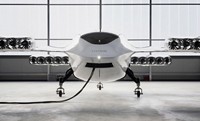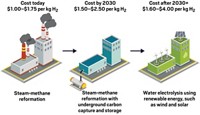Shrinking jet fuel's carbon footprint
Emissions from burning jet fuel make up a large portion of commercial airlines’ environmental impact. Airlines are looking to reduce this with alternative fuels

When airline executives think about how to make air travel more sustainable, the biggest arrow points to the fuel burned to keep planes in the air. "For short-haul flights, there's some encouraging movement for zero-emission planes, such as those running on electricity," Pavlenko says. "But for everything else, it comes down to what fuel you can switch to."
The goal of using sustainable aviation fuels, or SAFs, is to reduce the amount of greenhouse gases emitted during the lifetime of the fuels, from production to combustion, compared with current petroleum-based jet fuels. The scale of that reduction depends on the process used to make the fuel and the carbon source. And even though some SAFs boast significant emission reductions, few are made at large scale.
Pathway to Fischer-Tropsch synthetic paraffinic kerosenes
To make Fischer-Tropsch synthetic paraffinic kerosenes, industrial chemists oxidize the carbon source to synthesis gas, a mixture of carbon monoxide and hydrogen, and then run this gas over an iron, cobalt, or ruthenium catalyst to produce hydrocarbons. They then blend the products with fossil-derived jet fuels before the result can be burned in a jet engine.

Sources: International Council on Clean Transportation, National Energy Technology Laboratory
Note: In the Fischer-Tropsch reaction scheme, n indicates the number of carbons in the resulting hydrocarbons. For sustainable aviation fuels, that number is usually between 10 and 20.
Generally, commercial airliners use kerosene fuels called Jet A and Jet A-1. They're mixtures of paraffins, naphthenes, aromatics, and olefins and are mostly derived from petroleum. Some companies, such as Airbus, which declined to be interviewed for this story, are looking to hydrogen as a fuel, since it combusts to produce water vapor. But developing H2-burning engines is in early stages, so such planes are still far in the future.
Most companies are looking instead at drop-in fuels, or fuels that can work with existing jet engines. They need to have similar properties to jet fuel, including their energy released when burned, performance at low temperatures, and flow. These specifications ensure that the fuels will behave the same way fossil-derived jet fuel does in an airplane's engine, Pavlenko says. One way fuel manufacturers get SAFs to match these specifications is by blending them with conventional jet fuel, he says. How much is blended varies quite a bit, however. Most SAFs need to be blended 50:50 with Jet A-1. And while there's interest in SAFs that don't need to be blended, none have been commercially approved, according to Pavlenko. The standards these 100% SAF fuels would have to meet haven't even been set yet and will take probably 3–5 years to get completed, Rick Barraza, vice president of administration at the alternative-fuel company Fulcrum BioEnergy, says in an email.
There are three main ways to make SAFs: from hydroprocessed esters and fatty acids (HEFA), Fischer-Tropsch synthetic paraffinic kerosene (FT-SPK), and alcohol-to-jet synthetic paraffinic kerosene (ATJ-SPK). All three can be used at similar blend levels, around 50%.
To make HEFA fuels, industrial scientists remove the oxygens from molecules in unused vegetable oils, or waste fats, oils, and greases. Then they treat the mixtures with hydrogen to yield burnable hydrocarbons the right length for jet fuel, usually between 10 and 20 carbons long, according to the ICCT. Compared with Jet A and Jet A-1, these fuels are the most cost competitive SAF technology, Pavlenko says.
To make Fischer-Tropsch-SPK, scientists oxidize a wide variety of plant and human wastes and residues to make synthesis gas, a mixture of H2and carbon monoxide. Adding a catalyst—usually iron, cobalt, or ruthenium—to this gas triggers Fischer-Tropsch synthesis, which produces hydrocarbons.
The sources for alcohol-to-jet-SPK are crops such as sugarcane and corn, plant and agriculture wastes, and in some cases industrial flue gases. Generally, scientists convert these feedstocks to ethanol or isobutyl alcohol and then upgrade the alcohols to long-chain kerosene by removing water, treating them with hydrogen, and combining short-chain hydrocarbons to form longer ones.
Fickle fuels
Depending on the carbon source, sustainable aviation fuels can produce a large range of greenhouse gases over their lifetimes. Scientists compare these fuels’ carbon footprints by looking at the life-cycle carbon intensity, measured in grams of CO2 equivalent (g CO2e) released per megajoule of energy burned.

Sources: International Council on Clean Transportation, International Civil Aviation Organization.
a Not including plastic municipal solid waste.
These three alternative fuels don't have the same impact on the environment. The ICCT recently released a report showing the amount of greenhouse gases emitted during various alternative fuels' life cycles, including growing or collecting the carbon sources, synthesizing the fuels, and combusting them in an engine. The data came from the International Civil Aviation Organization's Carbon Offsetting and Reduction Scheme for International Aviation program, a United Nations effort.
The ICCT found that alcohol-to-jet-SPK fuels tend to have higher emissions than HEFA or Fischer-Tropsch-SPK fuels because making alcohols from starch-based crops takes a lot of energy and emits substantial amounts of greenhouse gases. In general, biofuels made from wastes and by-products tend to have lower greenhouse gas emissions than crop-based ones, the ICCT's Pavlenko says.
The SAF industry is shifting more to such waste-based fuels, according to Aaron Robinson, senior manager of environmental strategy and sustainability for United Airlines. Ten years ago, alternative-fuel companies focused on growing crops for biofuels. "Two out of our first three SAF flights were powered by agriculturally grown material," he says. "That's the way we thought the industry was going to be going." But life-cycle analyses have shown how environmentally costly that route can be. When the fuel source is a food crop, the process contributes to deforestation because more land is needed to grow the additional crops, Pavlenko says.
No fuel companies currently produce Fischer-Tropsch-SPKs, so the fuel currently in production with the lowest lifetime GHG emissions is HEFA, depending on the feedstocks. "Some SAFs actually don't offer very many, if any, greenhouse gas savings at all, such as palm oil–derived biofuel, whereas others can have greenhouse gas reductions approaching 100%," Pavlenko says. Used cooking oil and waste animal fats have lower lifetime emissions and are more popular than palm oil, he says.
The company closest to commercial production of Fischer-Tropsch-SPKs is Fulcrum BioEnergy in Pleasanton, California. This company's technology uses municipal solid waste, also known as trash, to make jet fuel. Fulcrum plans to start producing biofuel in the last quarter of this year at its plant just east of Reno, Nevada, Vice President Barraza says. The company plans to build eight other plants with a total production of about 1.5 billion L per year, enough to meet the needs of United and other partners, which include Cathay Pacific Airways and Japan Airlines, Barraza says.
Using municipal solid waste as a feedstock for jet fuel could provide significant greenhouse gas emission savings. Generally, the breakdown of municipal solid waste in landfills produces methane, which has over 28 times the climate change impact of CO2 over 100 years. "By diverting [municipal solid waste] away from the landfill, we are thereby avoiding all that methane from being generated," Barraza says. The overall greenhouse gas life-cycle analysis for municipal solid waste fuel shows that this pathway can reduce greenhouse gas emissions by over 85% compared with fossil fuels. But the key is the company must first remove plastic waste from the trash.
Plastic sitting in a landfill is actually a form of carbon storage, the ICCT's Pavlenko says. "But if you're converting it into fuel and combusting it, that carbon that would have been safely in the ground for a long time, now it's in the atmosphere," he says. Barraza says the waste feedstock the company uses is mostly organic or biogenic material. "We have the ability to remove a fair amount of the high-value plastics and metals from the raw MSW as part of our feedstock preparation process," he says.
Powering airplanes with waste is certainly the dream for sustainable flight, and a viable one, United's Robinson says. "You could power all of United using just 20% of US landfill waste."
But the reality is that relative to total amounts of jet fuel, airlines aren't using a lot of SAFs right now. "It's less than 0.1% globally," Pavlenko says. For example, United has used about 3.8 million L of SAFs per year in recent years, compared with more than 15 billion L per year of conventional jet fuel, Robinson says. To bump up the amount of SAFs it has access to, United has struck deals with Fulcrum and World Energy, he says. Delta and JetBlue have agreements to purchase SAFs from the Finnish company Neste. These agreements give airlines both price and source certainty for future fuels and provide the fuel companies with a future market for their products.
Fulcrum's Barraza declines to provide details about the timeline for delivering the fuel the firm has promised to United. The big question, Robinson says, is how much the fuel is going to cost and if United can get it soon enough to make a difference in lowering emissions.











Join the conversation
Contact the reporter
Submit a Letter to the Editor for publication
Engage with us on Twitter